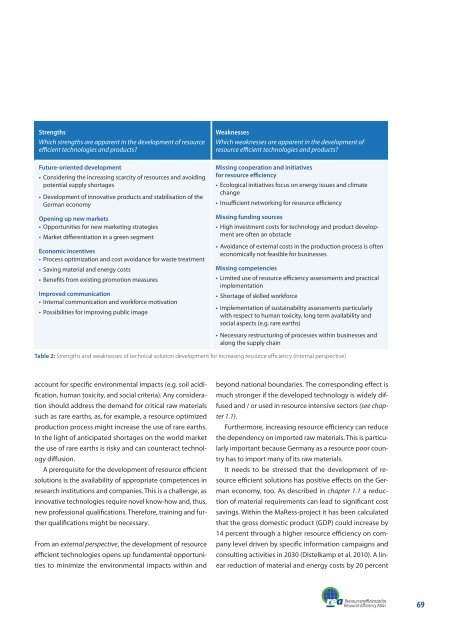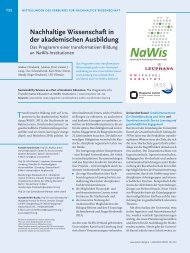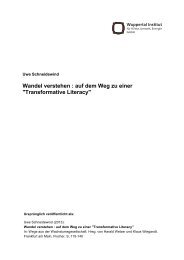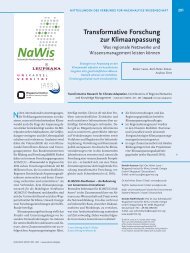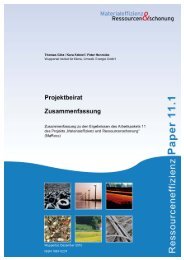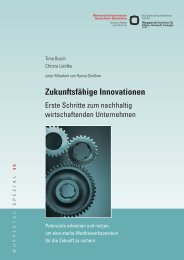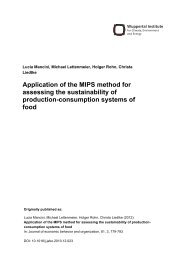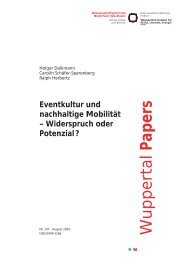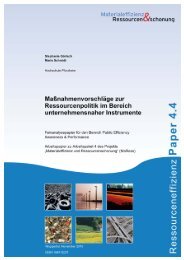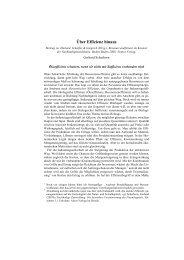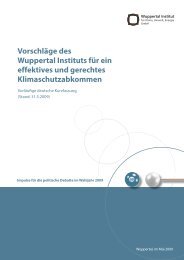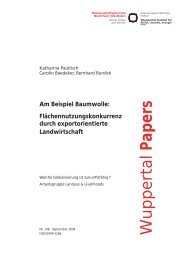Resource Efficiency Atlas - Publication Server of the Wuppertal ...
Resource Efficiency Atlas - Publication Server of the Wuppertal ...
Resource Efficiency Atlas - Publication Server of the Wuppertal ...
You also want an ePaper? Increase the reach of your titles
YUMPU automatically turns print PDFs into web optimized ePapers that Google loves.
Strengths<br />
Which strengths are apparent in <strong>the</strong> development <strong>of</strong> resource<br />
efficient technologies and products?<br />
Future-oriented development<br />
Considering <strong>the</strong> increasing scarcity <strong>of</strong> resources and avoiding<br />
potential supply shortages<br />
Development <strong>of</strong> innovative products and stabilisation <strong>of</strong> <strong>the</strong><br />
German economy<br />
Opening up new markets<br />
Opportunities for new marketing strategies<br />
Market differentiation in a green segment<br />
Economic incentives<br />
Process optimization and cost avoidance for waste treatment<br />
Saving material and energy costs<br />
Benefits from existing promotion measures<br />
Improved communication<br />
Internal communication and workforce motivation<br />
Possibilities for improving public image<br />
account for specific environmental impacts (e.g. soil acidi-<br />
fication, human toxicity, and social criteria). Any considera-<br />
tion should address <strong>the</strong> demand for critical raw materials<br />
such as rare earths, as, for example, a resource optimized<br />
production process might increase <strong>the</strong> use <strong>of</strong> rare earths.<br />
In <strong>the</strong> light <strong>of</strong> anticipated shortages on <strong>the</strong> world market<br />
<strong>the</strong> use <strong>of</strong> rare earths is risky and can counteract technol-<br />
ogy diffusion.<br />
A prerequisite for <strong>the</strong> development <strong>of</strong> resource efficient<br />
solutions is <strong>the</strong> availability <strong>of</strong> appropriate competences in<br />
research institutions and companies. This is a challenge, as<br />
innovative technologies require novel know-how and, thus,<br />
new pr<strong>of</strong>essional qualifications. Therefore, training and fur-<br />
<strong>the</strong>r qualifications might be necessary.<br />
From an external perspective, <strong>the</strong> development <strong>of</strong> resource<br />
efficient technologies opens up fundamental opportunities<br />
to minimize <strong>the</strong> environmental impacts within and<br />
Weaknesses<br />
Which weaknesses are apparent in <strong>the</strong> development <strong>of</strong><br />
resource efficient technologies and products?<br />
Missing cooperation and initiatives<br />
for resource efficiency<br />
Ecological initiatives focus on energy issues and climate<br />
change<br />
Insufficient networking for resource efficiency<br />
Missing funding sources<br />
High investment costs for technology and product development<br />
are <strong>of</strong>ten an obstacle<br />
Avoidance <strong>of</strong> external costs in <strong>the</strong> production process is <strong>of</strong>ten<br />
economically not feasible for businesses<br />
Missing competencies<br />
Limited use <strong>of</strong> resource efficiency assessments and practical<br />
implementation<br />
Shortage <strong>of</strong> skilled workforce<br />
Implementation <strong>of</strong> sustainability assessments particularly<br />
with respect to human toxicity, long term availability and<br />
social aspects (e.g. rare earths)<br />
Necessary restructuring <strong>of</strong> processes within businesses and<br />
along <strong>the</strong> supply chain<br />
Table 2: Strengths and weaknesses <strong>of</strong> technical solution development for increasing resource efficiency (internal perspective)<br />
beyond national boundaries. The corresponding effect is<br />
much stronger if <strong>the</strong> developed technology is widely diffused<br />
and / or used in resource intensive sectors (see chap-<br />
ter 1.1).<br />
Fur<strong>the</strong>rmore, increasing resource efficiency can reduce<br />
<strong>the</strong> dependency on imported raw materials. This is particu-<br />
larly important because Germany as a resource poor coun-<br />
try has to import many <strong>of</strong> its raw materials.<br />
It needs to be stressed that <strong>the</strong> development <strong>of</strong> resource<br />
efficient solutions has positive effects on <strong>the</strong> German<br />
economy, too. As described in chapter 1.1 a reduction<br />
<strong>of</strong> material requirements can lead to significant cost<br />
savings. Within <strong>the</strong> MaRess-project it has been calculated<br />
that <strong>the</strong> gross domestic product (GDP) could increase by<br />
14 percent through a higher resource efficiency on company<br />
level driven by specific information campaigns and<br />
consulting activities in 2030 (Distelkamp et al. 2010). A linear<br />
reduction <strong>of</strong> material and energy costs by 20 percent<br />
Ressourceneffizienzatlas<br />
<strong>Resource</strong> <strong>Efficiency</strong> <strong>Atlas</strong> 69


